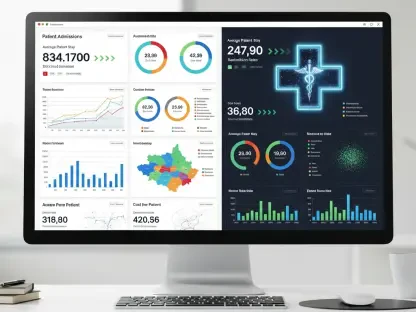The recent recognition of Sunderland Royal Hospital with the prestigious HIMSS Level 7 status marks a significant milestone in its journey toward digital healthcare transformation. This achievement, bestowed by the Healthcare Information Management and Systems Society (HIMSS), underscores the hospital’s advanced use of digital technologies to not only enhance patient care but also bolster operational efficiency. The virtual assessment, conducted over two days in December 2020, meticulously evaluated various clinical and operational processes. Central to this evaluation was the hospital’s utilization of the Meditech electronic patient record (EPR) system, a powerful tool that enables clinicians to access real-time patient data across all departments, thereby significantly improving the quality and safety of patient care.
Seamless Integration and Data Sharing
One of the cornerstones of Sunderland Royal Hospital’s journey to achieving HIMSS Level 7 status is its seamless integration of the electronic patient record system with the Great North Care Record. This integration facilitates efficient and secure data sharing across multiple healthcare settings in the North East and North Cumbria. Such interoperability is crucial for providing continuity of care, as it allows healthcare providers to access comprehensive patient histories, thus making more informed clinical decisions. Dr. Kevin Joisce, a consultant in emergency medicine and Chief Clinical Information Officer (CCIO) at South Tyneside and Sunderland NHS Foundation Trust, emphasized that this achievement is a testament to the dedication and hard work of the clinical staff. These teams have fully embraced digital systems to boost patient care, and their transition from paper-based processes to digital workflows has yielded significant improvements in both patient outcomes and operational efficiencies.
The integration with the Great North Care Record embodies a broader strategy of data-driven healthcare. It is about creating a cohesive system where patient information flows seamlessly, promoting enhanced care coordination and reducing redundancies. This connectivity not only helps in immediate clinical situations but also aids in long-term health management by providing a more complete picture of a patient’s health over time. Moreover, such systems are pivotal during emergencies as they enable quick access to critical patient data, potentially saving lives. The move away from paper records to digital platforms allows real-time updates and easy access to critical patient information, which is paramount in ensuring high standards of care.
Commitment to Digital Excellence
The broader commitment of Sunderland Royal Hospital’s Board to advancing digital technologies has been a driving force behind this notable accomplishment. Their unwavering pursuit of digital excellence has propelled the hospital’s digital maturity, enabling it to secure HIMSS Level 7 status. This accolade places Sunderland Royal Hospital alongside other esteemed institutions like Cambridge University Hospitals and Great Ormond Street Hospital, both of which are also renowned for their advanced digital capabilities. Such a commitment requires not only an investment in cutting-edge technology but also a cultural shift within the organization. The Board’s vision for a digital-first approach has steered various initiatives aimed at embedding digital processes into all clinical workflows, thus fostering a culture of continuous improvement.
John Rayner, Regional Director at HIMSS, highlighted the significant progress made by Sunderland Royal Hospital since its HIMSS Level 6 validation in January 2020. Despite the challenges posed by the pandemic, including the necessity of virtual assessments, the hospital successfully met the stringent criteria for Level 7. Rayner lauded the team for their clear commitment to leveraging technology to foster patient safety and elevate the overall quality of clinical care. This progression from Level 6 to Level 7 represents not just a technological upgrade but a holistic advancement in how healthcare is delivered and managed within the institution. It reflects an overarching strategy aimed at integrating cutting-edge digital tools to create a smarter, safer, and more efficient healthcare environment.
Leadership in Digital Healthcare Transformation
Sunderland Royal Hospital’s Board has significantly advanced the hospital’s digital maturity, earning it the prestigious HIMSS Level 7 status. This recognition places it among elite institutions like Cambridge University Hospitals and Great Ormond Street Hospital, both known for their advanced digital initiatives. Achieving this required not just investment in the latest technology but also a cultural transformation within the hospital. The Board’s vision for a digital-first strategy has driven various initiatives, embedding digital processes into all clinical workflows and fostering a culture of continuous improvement.
John Rayner, Regional Director at HIMSS, noted the remarkable progress Sunderland Royal Hospital has made since its Level 6 validation in January 2020. Despite pandemic-related challenges, including the shift to virtual assessments, the hospital met the rigorous criteria for Level 7. Rayner praised the team’s dedication to using technology to enhance patient safety and improve the quality of clinical care. This leap from Level 6 to Level 7 is more than just a tech upgrade; it represents a comprehensive enhancement in healthcare delivery and management, reflecting an overarching strategy to integrate cutting-edge digital tools for a smarter, safer, and more efficient healthcare environment.









